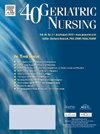Potential profiles of social isolation in elderly stroke patients: A cross-sectional study
IF 2.4
3区 医学
Q3 GERIATRICS & GERONTOLOGY
引用次数: 0
Abstract
Aim
Social isolation is a psychological state resulting from insufficient interpersonal interaction, marked by loneliness, helplessness, and unmet social needs following voluntary or involuntary social withdrawal. It may negatively impact the quality of life in elderly stroke patients. Due to its subtle nature and the varying clinical presentations and intervention needs across demographic groups, exploring its characteristics and influencing factors in this population holds important clinical value.
Methods
A total of 376 elderly stroke patients were surveyed between January and October 2024 using the Generalized Alienation Scale (GAS), Fear of Progression Questionnaire–Short Form (FoP-Q-SF), Distress Disclosure Index (DDI), and Stroke Stigma Scale (SSS). Latent profile analysis was employed to classify participants based on social isolation variables, and multinomial logistic regression was used to identify subgroup-specific influencing factors related to demographic and clinical characteristics.
Results
Three subgroups were identified: "low social isolation group" (C1), "moderate social isolation group" (C2), and "high social isolation group" (C3). Multivariate logistic regression analysis revealed that living alone, monthly household income, family status, physical disabilities, fear of disease progression, and stigma are significant influencing factors among these subgroups.
Conclusions
The study identified three distinct subgroups of elderly stroke patients marked by varying levels of social isolation. To effectively reduce social isolation and improve rehabilitation outcomes, health care professionals should design targeted interventions tailored to the specific characteristics of each subgroup.
老年脑卒中患者社会隔离的潜在特征:一项横断面研究
社会孤立是一种由于人际交往不足而产生的心理状态,其特征是孤独、无助、社会需求得不到满足,并伴有自愿或非自愿的社会退缩。它可能会对老年脑卒中患者的生活质量产生负面影响。由于其微妙的性质和不同人口群体的临床表现和干预需求不同,探索该人群的特征和影响因素具有重要的临床价值。方法采用广义疏离感量表(GAS)、进展恐惧简易问卷(top - q - sf)、痛苦披露指数(DDI)和脑卒中耻感量表(SSS)对376例老年脑卒中患者进行调查。基于社会隔离变量,采用潜在特征分析对受试者进行分类,并采用多项逻辑回归分析确定与人口统计学和临床特征相关的亚组特异性影响因素。结果分为“低社会隔离组”(C1)、“中等社会隔离组”(C2)和“高社会隔离组”(C3)。多因素logistic回归分析显示,独居、家庭月收入、家庭状况、身体残疾、对疾病进展的恐惧和病耻感是这些亚群的显著影响因素。该研究确定了老年中风患者的三个不同的亚组,这些亚组的特征是不同程度的社会孤立。为了有效地减少社会隔离和改善康复结果,卫生保健专业人员应根据每个亚群体的具体特征设计有针对性的干预措施。
本文章由计算机程序翻译,如有差异,请以英文原文为准。
求助全文
约1分钟内获得全文
求助全文
来源期刊

Geriatric Nursing
医学-护理
CiteScore
3.80
自引率
7.40%
发文量
257
审稿时长
>12 weeks
期刊介绍:
Geriatric Nursing is a comprehensive source for clinical information and management advice relating to the care of older adults. The journal''s peer-reviewed articles report the latest developments in the management of acute and chronic disorders and provide practical advice on care of older adults across the long term continuum. Geriatric Nursing addresses current issues related to drugs, advance directives, staff development and management, legal issues, client and caregiver education, infection control, and other topics. The journal is written specifically for nurses and nurse practitioners who work with older adults in any care setting.
 求助内容:
求助内容: 应助结果提醒方式:
应助结果提醒方式:


